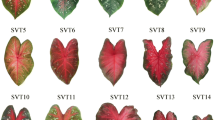Summary
The chlorophyll deficient tl mutant of Nicotiana tabacum var ‘Samsun’ expresses green, clear and twin, green and clear somatic variations spontaneously on leaves at a low frequency. This character is maintained after both vegetative multiplication and sexual reproduction. However a very important phenotypic variability in the capacity for somatic variation appears in in vitro bud neoformations from leaf fragments of tl/tl homozygous plants. This variability is observed in the type of variations and the variation pattern, defined as the frequency and size of the variant areas.
The present work was aimed at determining both the cell frequencies of the events which lead to the somatic variation and the preferential sequence of leaf initial development during which these frequencies are at a maximum. It was limited to plant populations with very different patterns for green variations, some having a high frequency of large variation, others having a high frequency of small variations. They were compared with a population of control plants having a low frequency.
In the case of plants having a high frequency of large green variations, the events leading to somatic variation occurred between the twenty-first and the twelfth cell cycles preceding the end of the initial division phase, the maximum cell frequencies being in the seventeenth and sixteenth cycles. The maximum frequencies appeared extremely high, being on average about 10−2. In plants with a high frequency of small green variations the event occurred between cell cycles nine and one, with mean frequencies of 10−3 but without any clearly marked maximum. In the low frequency control plants the event also took place during the last ten cell cycles but with decreasing frequencies from 10−4 to 10−7.
The frequency and the starting period of the cell events leading to somatic variation are closely dependent on the state of the cell. This is, on the one hand, strictly linked to the physiology of the plant and, on the other, closely correlated with the stage of differentiation, which may vary according to the genetic back ground of the leaf initial cells.
The results are discussed in relation to comparable observations and the relevant interpretations made on other instability mutants.
Similar content being viewed by others
Literature
Anderson, E.G.; Eyster, W.H.: Pericarp studies in Maize. III. The frequency of mutation in variegated maize pericarp. Genetics 13, 111–120 (1928)
Ashmann, R.B.: Mutants from maize plants heterozygous R r R st and their association with crossing over. Genetics 51, 305–312 (1965)
Avery, G.S.: Structure and development of tobacco leaf. Am. J. Bot. 20, 565–592 (1933)
Brink, R.A.; Williams, E.: Mutable R Navajo alleles of cyclic origin in Maize. Genetics 73, 273–296 (1973)
Cornu, A.: Systèmes instables induits chez le Petunia. Mutation Res. 42, 235–238 (1977)
Demerec, M.: Behaviour of two mutables gene of Delphinium ajacis. XXIV, 179–193 (1930)
Deshayes, A.: Rapport d'activité 1968–1972. Station d'Amélioration des Plantes, Inra Dijon. pp. A19–A26 (1972)
Deshayes, A.: Mise en evidence d'une corrélation entre la fréquence de variations somatiques sur feuilles et l'état physiologique d'un mutant chlorophyllien monogénique chez Nicotiana tabacum var. ‘Samsun’. Mutation Res. 17, 323–334 (1973)
Deshayes, A.: Effets de cycles successifs de néoformation de bourgeons in vitro sur l'aptitude à la variation somatique chez un mutant chlorophyllien de Nicotiana tabacum var. ‘Samsun’. Mutation Res. 35, 221–246 (1976)
Dulieu, H.: Emploi de chimères chlorophylliennes pour l'étude de l'ontogénie foliaire. Bull. Sci. Bourgogne XXV, 1–60 (1968)
Faberge, A.C.; Beale, G.H.: An unstable gene in Portulaca: Mutation rate at different temperatures. J. Genet. 43, 173–187 (1942)
Fincham, J.R.S.; Harrison, B.J.: Instability at the pal locus in Antirrhinum majus. II. Multiple alleles produced by mutation of one original unstable allele. Heredity 22, 211–224 (1967)
Fincham, J.R.S.; Sastry, G.R.K.: Controlling element in Maize. Ann. Rev. Genet. 8, 15–50 (1974)
Gavazzi, G.: Control of gene action in the synthesis of Anthocyanin in Maize. Mol. Gen. Genet. 99, 151–164 (1967)
Harrison, B.J.; Fincham, J.R.S.: Instability at the pal locus in Antirrhinum majus I. Effects of environment on frequencies of somatic and germinal mutation. Heredity 19, 237–258 (1964)
Harrison, B.J.; Fincham, J.R.S.: Instability at the pal locus in Antirrhinum majus III. A gene controlling mutation frequency. Heredity 29, 67–72 (1973)
Hill, R.F.: Synergistic effect of Escherechia Coli mutation gene on mutagenesis by UV radiation and by alkylating. Mutation Res. 14, 23–31 (1972)
McClintock, B.: The suppressor-mutator system of control of gene action in maize. Carnegie. Inst. Washington Yearbook 57, 415–429 (1958)
McClintock, B.: The control of gene action in maize. Brookhaven Symp. Biol. 18, 162–184 (1965)
McClintock, B.: Components of action of the regulators Spm and Ac. Carnegie. Inst. Washington Yearbook 64, 527–536 (1965)
McClintock, B.: The states of a gene locus in maize. Carnegie. Inst. Washington Yearbook. 66, 20–28 (1968)
Peterson, P.A.: The effect of temperature on the mutation rate of a mutable locus in maize J. Hered. XLIX, 120–124 (1958)
Peterson, P.A.: Phase variation of controlling element in maize. Genetics 54, 249–266 (1965)
Rhoades, M.M.: The genetic control of mutability in maize. Cold. Spring. Harb. Symp. Quant. Biol. 9, 138–144 (1941)
Sand, S.A.: Phenotypic variability and the influence of temperature on somatic instability in a culture derived from hybrids between Nicotiana langsdorfii and Nicotiana sanderae. Genetics 42, 685–703 (1957)
Sand, S.A.: Temperature response of the genetically stable R locus in comparison with the mutable V locus in a clone of Nicotiana. Nature 196, 91–92 (1962)
Sastry, G.R.K.: Evocation of instability at the pal locus in Antirrhinum majuc. Heredity 36, 315–329 (1976)
Sparrow, A.H.; Sparrow, R.C.: Spontaneous somatic mutation frequencies for flower color in several Tradescentia species and hybrids. Environ. Exp. Bot. 16, 23–43 (1976)
Author information
Authors and Affiliations
Additional information
Communicated by D. von Wettstein
Rights and permissions
About this article
Cite this article
Deshayes, A. Cell frequencies of green somatic-variations in the tl chlorophyll mutant of Nicotiana tabacum var ‘Samsun’. Theoret. Appl. Genetics 55, 145–152 (1979). https://doi.org/10.1007/BF00295441
Received:
Issue Date:
DOI: https://doi.org/10.1007/BF00295441




